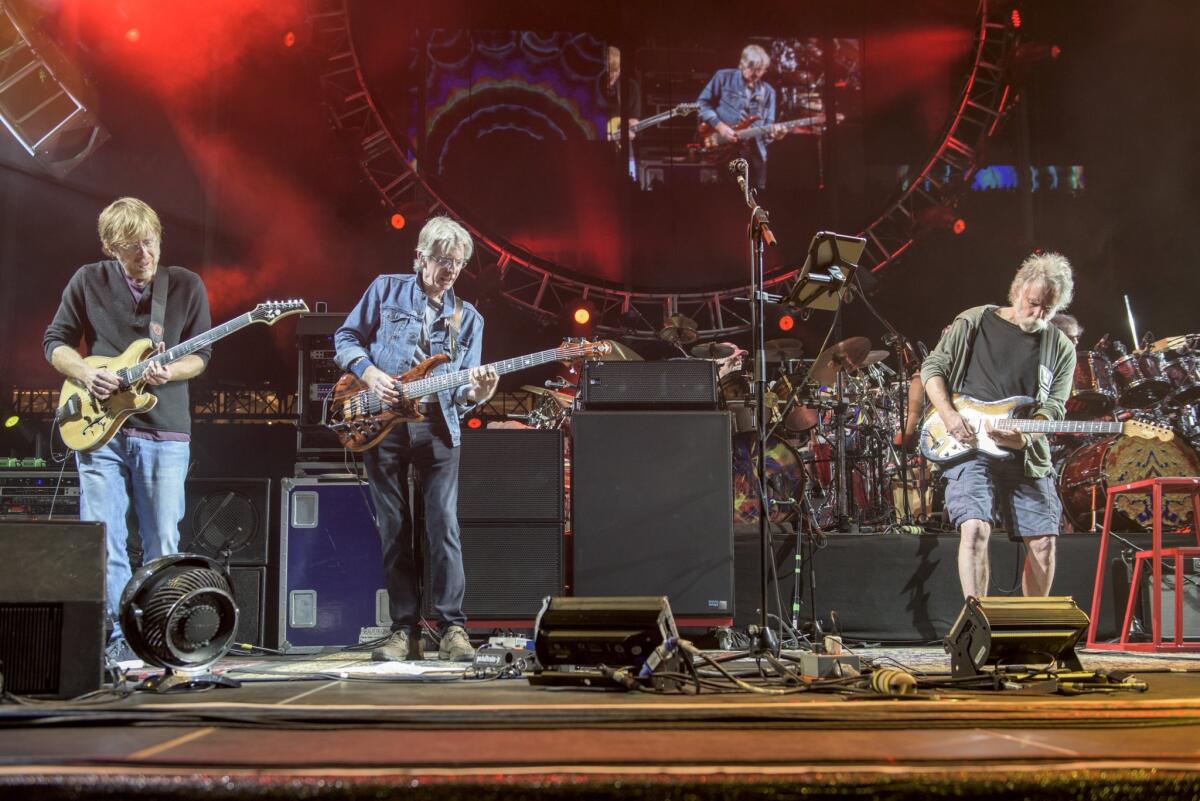The Grateful Dead and the old, weird America

Trey Anastasio, from left, Phil Lesh and Bob Weir perform at the Grateful Dead Fare Thee Well Show at Levi’s Stadium on Saturday in Santa Clara, Calif.
For about 10 minutes on Sunday morning, I regretted not going to Santa Clara to hear the Grateful Dead. This was after I saw the set list from the first of the five “Fare Thee Well” shows scheduled to conclude July 3, 4 and 5 at Chicago’s Soldier Field.
“Alligator,” “Cream Puff War,” “What’s Become of the Baby?” — these were songs they hadn’t played live, if at all, in close to five decades. And yet, there was no Jerry Garcia. How could it be the Dead without Jerry Garcia, who died in 1995? This was a key reason I’d dismissed these goodbye shows; how could you say goodbye to something that was already gone?
My last Dead show was at the Spectrum in Philadelphia on April 6, 1982. Even then, my relationship with the band was ambivalent; I was an admirer of the intent if not always the execution of the music, the ideal of improvisation, making mistakes in public, but wary of nostalgia, then and now.
What, though, if “Fare Thee Well” were bigger than nostalgia? What if something else were going on?
In a recent blog post, Peter Richardson makes such an argument. “[T]heir concerts,” he explains, “expanded the social space for the experience of total rapture; their tours furnished fans with the opportunity for adventure; and those fans could experience that ecstasy and adventure in a large, vibrant, and cohesive community. … Now, two decades after the band dissolved, that community will have a few more chances to commune.”
Richardson teaches at San Francisco State and is the author of “No Simple Highway: A Cultural History of the Grateful Dead,” which offers an insightful look at the subculture that surrounds the band. This notion of community — a gathering of the tribes — resides at its center, offering a context, a frame of reference, as it were.
Let’s call this, as Greil Marcus has, “the old, weird America,” the America of bindlestiffs and blues songs, Jack Black and Boxcar Bertha, the Wobblies and Eugene V. Debs.
“I owe a lot of who I am and what I’ve been and what I’ve done to the beatniks from the Fifties and to the poetry and art and music that I’ve come in contact with,” Garcia said in 1991. “I feel like I’m part of a continuous line of a certain thing in American culture, of a root.”
Garcia’s statement comes from the book “Garcia,” a collection of interviews and profiles put together by the editors of Rolling Stone after the guitarist’s death. Along with “No Simple Highway,” it occupies a surprisingly short shelf of good writing about the band.
Why is this? Too much hagiography for one thing — which is, I think, the flipside of the community that Richardson invokes.
“[T]hey’ve allowed themselves the latitude to enjoy a show for lots of different reasons,” Garcia once said about the Deadheads. “I think that’s in their favor — no matter what the experience has been, they don’t get burned.”
That’s true, of course — I’ve been there — but it also highlights a certain complacency that even the members of the band eventually came to feel.
“We’ve been running on inertia for quite a long time,” Garcia admits in “Garcia.” “I mean, insofar as we have a huge overhead, and we have a lot of people that we’re responsible for, who work for us and so forth, we’re reluctant to do anything to disturb that. We don’t want to take people’s livelihoods away. But it’s us out there, you know. And in order to keep doing it, it has to be fun.”
Throughout his career, Garcia found that fun in outside projects, including “Harrington Street,” an autobiography in words and pictures, published posthumously, that I admire for its offhand grace.
Recalling his earliest memory, of being thrown in a swimming pool as a toddler, Garcia writes, “I clearly remember sinking majestically to the bottom, the soothing hum of underwater humming in my ears.”
Consider those descriptors (“majestically,” “soothing”) and you start to see the creation of a consciousness. That sense of — what? acceptance? being present in the moment? — captures what Garcia and the Dead meant at their best.
“Reality,” Garcia observes in another book, “The Wisdom of Jerry Garcia,” “is our own invention, which we have total access to in the most creative, direct, one-to-one sense.”
This is why I found the opening night set list from Santa Clara so compelling, because it suggests that, for one night at least, the surviving band members were on the trail of the authentic, or at least pushing against expectation, which for me has always been the whole idea.
Twitter: @davidulin
More to Read
Sign up for our Book Club newsletter
Get the latest news, events and more from the Los Angeles Times Book Club, and help us get L.A. reading and talking.
You may occasionally receive promotional content from the Los Angeles Times.











